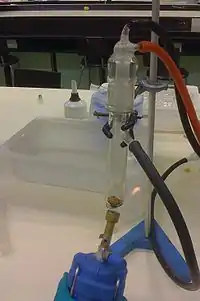Cold finger
A cold finger is a piece of laboratory equipment that is used to generate a localized cold surface. It is named for its resemblance to a finger and is a type of cold trap. The device usually consists of a chamber that a coolant fluid (cold tap water, or perhaps something colder) can enter and leave. Another version involves filling the device with a cold material (examples: ice, dry ice or a mixture such as dry ice/acetone or ice/water).[1]

Typically a cold finger is used in a sublimation apparatus,[2] or can be used as a compact version of a condenser in either reflux reaction or distillation apparatus. Many commercially available rotary evaporators can be purchased with a cold finger in place of a Dimroth condenser, for example. When used as a condenser in a rotary evaporator, cold fingers can be cooled to a lower temperature of −78 °C (dry ice), compared with water condensers that can be cooled to −40 °C (ethylene glycol/water mixture). The lower temperature achieved reduces the quantity of volatile material exhausted into the air.
Media
 A cold finger which includes a vacuum outlet.
A cold finger which includes a vacuum outlet.
 Dark green crystals of nickelocene, freshly sublimed on a cold finger.
Dark green crystals of nickelocene, freshly sublimed on a cold finger.
References
- Kenneth B. Wiberg (1960). Laboratory Technique in Organic Chemistry. McGraw-Hill. ISBN 0070700958.
- Zubrick, James W. (2016). "Sublimation". The Organic Chem Lab Survival Manual: A Student's Guide to Techniques (10th ed.). United States of America: John Wiley & Sons. pp. 192–194. ISBN 978-1118875780.